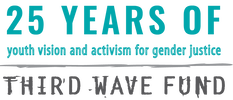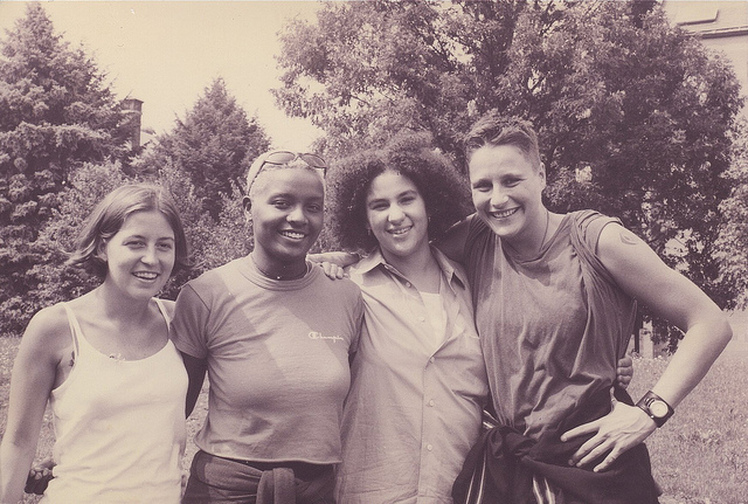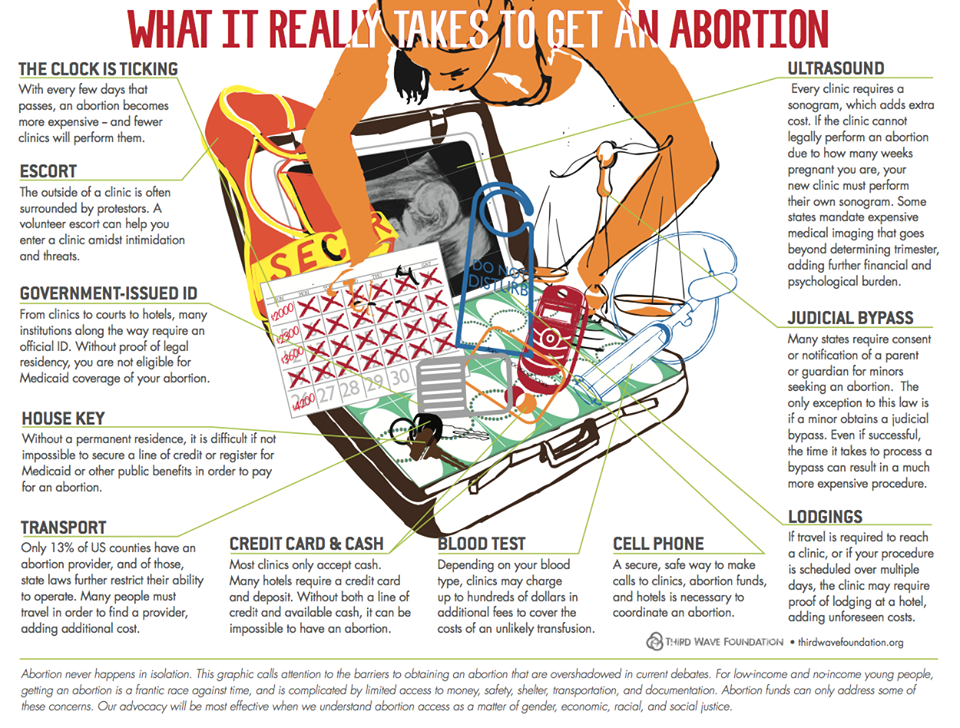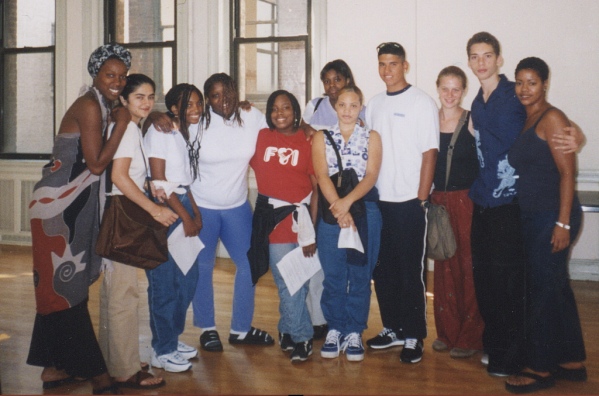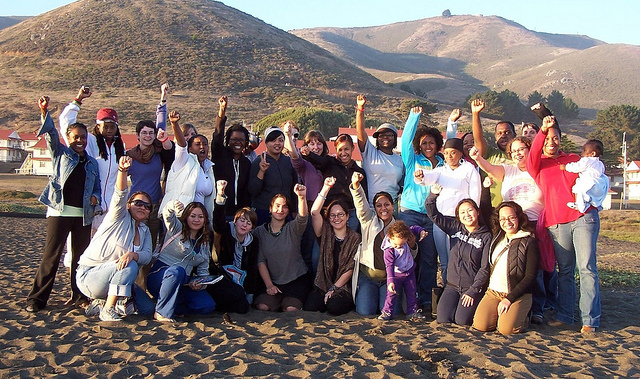Third Wave Fund History
The early 90s were packed with events that riveted and shocked young people, like the Rodney King trial and decision, the William Kennedy Smith rape trial, Clarence Thomas’s confirmation to the US Supreme Court, and the Supreme Court’s decision on Planned Parenthood vs. Casey, which upheld mandatory 24-hour waiting periods and other restrictions to abortion. All of these events brought new urgency to pressing issues that affect young women: sexual harassment, rape, race in America, reproductive health, economics, and class.
At the same time, no one was talking or listening to young women whose lives were most affected by these issues. The news media was almost always reflected white men discussing the ramifications of various legal arguments, not the reality of these issues, and not the impact they would have on young women’s lives.
In January 1992, Rebecca Walker wrote an article for Ms. magazine examining the impact of the Clarence Thomas confirmation. Her article was titled “Becoming the Third Wave.” Walker articulated a rage, anger, and hunger for action that resonated with young women and men across the country who wrote to Ms. declaring themselves part of the Third Wave. By May 1992, Walker and Shannon Liss started the Third Wave Direct Action Corporation. The organization’s initial mission was to fill a void in young women’s leadership and to mobilize young people to become more involved socially and politically in their communities.
Third Wave Direct Action’s inaugural project was Freedom Summer ‘92. In addition to registering or reaching out to more than 20,000 new voters, the result was a strong sense of community, empowerment, and leadership among the Freedom Summer Riders. For the next two years, Third Wave Direct Action Corporation continued to work with the nucleus of Freedom Summer alumni and other young women and men.
By 1995, Third Wave Direct Action’s priorities were responding to letters from young feminists around the country, growing the organization’s membership base, responding to the media’s misrepresentation of Gen X, and creating a lasting organization. In addition, much of Third Wave’s energy went toward finding creative ways to raise money for projects led by and for the young women whose stories were rarely told and whose voices were rarely heard.
At the same time, research from the philanthropic world was showing that less than four percent of all philanthropic dollars were directed to programs serving women and girls. Recognizing that even fewer dollars were making it to the innovative programs that Third Wave Direct Action members were leading across the country, Amy Richards and Rebecca Walker began having conversations with Catherine Gund and Dawn Martin about the need to have a fund for young women. Out of these conversations, the Third Wave Fund was born.
At the same time, no one was talking or listening to young women whose lives were most affected by these issues. The news media was almost always reflected white men discussing the ramifications of various legal arguments, not the reality of these issues, and not the impact they would have on young women’s lives.
In January 1992, Rebecca Walker wrote an article for Ms. magazine examining the impact of the Clarence Thomas confirmation. Her article was titled “Becoming the Third Wave.” Walker articulated a rage, anger, and hunger for action that resonated with young women and men across the country who wrote to Ms. declaring themselves part of the Third Wave. By May 1992, Walker and Shannon Liss started the Third Wave Direct Action Corporation. The organization’s initial mission was to fill a void in young women’s leadership and to mobilize young people to become more involved socially and politically in their communities.
Third Wave Direct Action’s inaugural project was Freedom Summer ‘92. In addition to registering or reaching out to more than 20,000 new voters, the result was a strong sense of community, empowerment, and leadership among the Freedom Summer Riders. For the next two years, Third Wave Direct Action Corporation continued to work with the nucleus of Freedom Summer alumni and other young women and men.
By 1995, Third Wave Direct Action’s priorities were responding to letters from young feminists around the country, growing the organization’s membership base, responding to the media’s misrepresentation of Gen X, and creating a lasting organization. In addition, much of Third Wave’s energy went toward finding creative ways to raise money for projects led by and for the young women whose stories were rarely told and whose voices were rarely heard.
At the same time, research from the philanthropic world was showing that less than four percent of all philanthropic dollars were directed to programs serving women and girls. Recognizing that even fewer dollars were making it to the innovative programs that Third Wave Direct Action members were leading across the country, Amy Richards and Rebecca Walker began having conversations with Catherine Gund and Dawn Martin about the need to have a fund for young women. Out of these conversations, the Third Wave Fund was born.
In 1997, and with much support from the philanthropic community and generous individuals, Third Wave Fund morphed into the Third Wave Foundation. Under the guidance of a multi-class, multi-gendered, multi-racial board comprised of 25 young people, Third Wave Foundation distributed almost $13,000 in grants its very first year. The initial individuals and groups supported and laid the base upon which future grantmaking would be built: emergency funding for abortions, scholarships, building young-women-led reproductive rights organizations, and providing general operating support for young-women-led groups and projects.
Third Wave was created as a multi-issue feminist organization that supported the leadership and vision of young women as they worked on issues like environmental justice, prison reform, living wage campaigns, as well as on more traditional feminist issues like reproductive rights. Third Wave’s definition of feminism explicitly connects women’s issues to issues of race, sexuality, class, and ability.
Third Wave was created as a multi-issue feminist organization that supported the leadership and vision of young women as they worked on issues like environmental justice, prison reform, living wage campaigns, as well as on more traditional feminist issues like reproductive rights. Third Wave’s definition of feminism explicitly connects women’s issues to issues of race, sexuality, class, and ability.
Past Third Wave Initiatives
1998-2011 | Emergency Abortion Fund
Third Wave’s Emergency Abortion Fund sought to prevent economic injustice from determining the reproductive lives of young people, particularly young people of color. Before closing in 2011, this fund awarded grants to over 2,000 people in need. Through the Emergency Abortion Fund, Third Wave sought to dis-entwine one’s belonging to an underprivileged group from one’s ability to access emergency reproductive care.
The Emergency Abortion Fund was one of Third Wave Foundation’s first grantmaking programs, responding to a critical need in the lives of young people across the United States. We thank our many abortion fund interns, who served as front-line support for thousands of callers. We also wish to thank the countless individuals whose gifts allowed us to operate the Emergency Abortion Fund, along with support from The Dyson Foundation and the Richard and Rhoda Goldman Fund.
The Emergency Abortion Fund was one of Third Wave Foundation’s first grantmaking programs, responding to a critical need in the lives of young people across the United States. We thank our many abortion fund interns, who served as front-line support for thousands of callers. We also wish to thank the countless individuals whose gifts allowed us to operate the Emergency Abortion Fund, along with support from The Dyson Foundation and the Richard and Rhoda Goldman Fund.
*Third Wave is no longer funding abortion services. If you need funding for an abortion, the National Network of Abortion Funds maintains an online database of national and local funds, at fundabortionnow.org. You can also call the National Abortion Federation hotline at 800-722-9100.
2001 | Reaching Out Across Movements (ROAMS)
|
In an effort to build a progressive network of feminist activists, Third Wave developed ROAMS (Reaching Out Across Movements), a trip that brought young women activists together with progressive organizations in regions that are historically under-funded by national foundations.
ROAMS was an innovative program that combined Third Wave’s core issues of supporting activism, philanthropy, and leadership development opportunities for young women. |
Over three years, ROAMS connected young women with over 120 organizations in the Southeast, Pacific Northwest, and Southwest to discuss the challenges in their work and opportunities for young women’s activism. During ROAMS, Third Wave met with organizations working on a wide range of progressive social justice issues including reproductive rights, farm labor organizing, public education, lesbian and gay youth organizing, philanthropy, and groups working on other social justice issues.
2004 | The Reproductive Health & Justice Initiative
|
In 2004, Third Wave launched the Reproductive Health and Justice Initiative, a grantmaking project designed to strengthen the RJ movement and support work done by and for young women of color and trans- and gender-nonconforming youth under 30. In addition to the grantmaking, Third Wave held convenings of grant partners in order to provide space for peer exchanges, reflection on the movement, and to combat isolation.
|
Convening participants had a training to consider a range of collaborative work from alliances, networks, and coalitions. A working group of participants led another training to consider a range of options, and the groups decided to formalize into a network in October of 2006. This network (which was mainly but not exclusively made up of Third Wave’s grantees) sought to serve as a think tank and support system for and by marginalized communities in the reproductive justice movement. Together they laid the groundwork for shared action.
